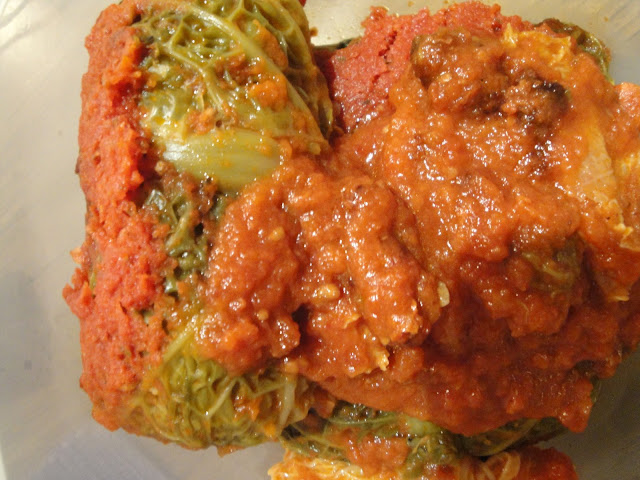There is something very comforting about panade on a dank, rainy west coast winter evening. Paired with a blanket, some sherry or wine, and a good movie, one's bones finally have some hope to warm up. After the excesses of the holiday season, panade is a great way to use up old bread and have a dinner that won't leave you feeling like a small anvil has taken up residence in your belly. Panade is a French term that means 'bread mash'. This particular panade recipe is a great way to showcase local Vancouver Island leeks, garlic, SaltSpring Montaña (hard sheep's cheese), and lovely locally made bread for the Dark Days Challenge.
This panade is easy to make and works as a main course for four, or a side dish for eight people.
 Ingredients
Ingredients1 1/2 pounds thinly sliced yellow onions
Up to 1/2 cup mild-tasting olive oil
6 cloves garlic, thinly sliced
Salt
1 pound leeks (upper third of green leaves removed), cleaned and cut into 1-inch-wide ribbons
10 ounces day-old chewy rice bread cut into rough 1-inch cubes
Up to 4 cups chicken stock
6 ounces Montaña (a hard sheep cheese or Gruyere will do), coarsely grated
1. Place the onions in a deep 4-quart saucepan and drizzle and toss with oil to coat, about 1/4 cup. Set over medium-high heat and cook until the bottom layer of onions is slightly golden around the edges, about 3 minutes. Stir and repeat.
2. Once the second layer of onions has colored, reduce the heat to low and stir in the garlic and a few pinches of salt. Stew, stirring occasionally, until the onions are a pale amber color and tender but not mushy, another 20 minutes or so. If at any point the onions look as if they may dry out, cover them to trap some of the moisture in the pan. Taste for salt. You should get about 2 1/4 cups cooked onions.
3. Preheat the oven to 325 degrees (or as low as 250 degrees, if it suits your schedule to stretch the cooking time from about 1 hour 45 minutes to 2 hours 45 minutes; the slower the bake, the more unctuous and mellow the results).
4. Place a few handfuls of leeks in a 3-quart saute pan or a 10-to 12-inch skillet with a drizzle of oil, a sprinkling of water (see David Leibovitz's instructions for washing leeks properly), and a few pinches of salt. Let the water start steaming, and stir the leeks about. They should be translucent. Test for salt and correct as necessary. Set aside.
5. Toss and massage the cubed bread with a few tablespoons of olive oil, a generous 1/4 cup of the stock and a few pinches of salt, to taste.
6. Choose a flameproof, 3-quart souffle dish or enameled cast-iron Dutch oven. Assemble the panade in layers, starting with a generous smear of onions, followed by a loose mosaic of bread cubes, a second layer of onions, a shimmering layer of leeks, and a handful of the cheese. Repeat, starting with bread, the onions and so on, until the dish is brimming. Aim for 2 to 3 layers of each component, then make sure the top layer displays a little of everything. Irregularity in the layers makes the final product more interesting and lovely. Drizzle with any remaining olive oil.
7. Bring the remaining 3 3/4 cups stock to a simmer and taste for salt. Add stock slowly, in doses, around the edge of the dish. For a very juicy, soft panade, best served on its own, like a soup or risotto, add stock nearly to the rim; for a firm but succulent panade, nice as a side dish, fill to about 1 inch below the rim. Wait a minute for stock to be absorbed, then add more to return to the desired depth. The panade may rise a little as the bread swells.
8. Set panade over low heat and bring to a simmer; look for bubbles around the edges (heating it here saves at least 30 minutes of oven time; it also means every panade you bake starts at the same temperature, so you can better predict total cooking times). Cover the top of the panade with parchment paper, then very loosely wrap the top and sides with foil. Place a separate sheet of foil under the panade or on the rack below it, to catch drips.
9. Bake until the panade is piping hot and bubbly. It will rise a little, lifting the foil with it. The top should be pale golden in the center and slightly darker on the edges. This usually takes about 1 1/2 hours, but varies according to shape and material of baking dish and oven. (You can hold the panade for another hour or so; just reduce the temperature to 275 degrees until 20 minutes before serving.)
10. Uncover panade, raise temperature to 375 degrees, and leave until golden brown on top, 10 to 20 minutes. (If you aren't quite ready when your panade is, re-tent the surface with parchment and foil and reduce the heat to 275 degrees. You can hold it another half hour this way without it overbrowning or drying out.) Slide a knife down the side of the dish and check the consistency of the panade. Beneath the crust, it should be very satiny and it should ooze liquid as you press against it with the blade of the knife. If it seems dry, add a few tablespoons simmering chicken stock and bake for 10 minutes longer.




























